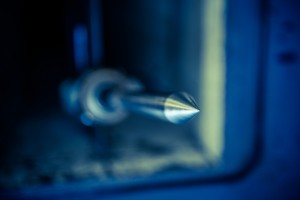The CSIR’s suite of wind tunnels has provided a scientific research and experimental foundation to the aerodynamic design efforts of the South African aeronautics industry over many years. Installed over a period of 30 to 35 years from the late 1960s onwards, the suite received its flagship, the transonic medium speed wind tunnel, in 1989.
The Low-speed wind tunnel (LSWT) is a continuous, single return wind tunnel with a closed test section. Strut mounted models are suspended from an overhead six component virtual-centre balance. An auxiliary pitch sector allows sting-supported models to be mounted on a variety of internal strain gauge balances.
Numerous test capabilities have been exercised in the LSWT namely;
• Scaled aircraft loads and static stability
• Pressure distribution
• Air data probe calibration
• Flutter
• Two-dimensional oscillating aerofoil
• Scaled racing vehicle tests
• Flow visualisation (oil flow, tufts, liquid crystals)
• Helicopter intake characterisation
• Propeller tests
LSWT specifications:
• Speed range: 5 m/s to 120 m/s
• Test section: 2.1 m x 1.5 m rectangular with corner fillets.
• Atmospheric tunnel
• Reynolds number: 6 x 10 6/m
The Seven-meter wind tunnel (7mWT) is a continuous, open circuit tunnel powered by 28 axial flow fans of 30 kW each. Uniform flow distribution across the speed range of the tunnel is given by running the fans in one of 13 different symmetrical patterns.
The test capabilities in the 7mWT include:
• Force measurement (internal balance, platform balance and rotor balance)
• Pressure measurement (Scanivalve system)
• Flow visualisation (tufts, oil flow, smoke)
• Flow field measurement (multi hole probes)
• UAV test rigs
• Propeller test rigs
7mWT specifications:
• Speed: 2 to 32 m/s in discreet steps
• Test section: 7,5 m x 6,5 m x 13 m
• Continuous, open circuit
The Medium-speed wind tunnel (MSWT) is one of the best-equipped and most sophisticated tunnels of its kind in the Southern Hemisphere. A 20 MW electric motor drives a three stage axial compressor with variable guide vanes and stator blade angles for accurate Mach number control. This variable density transonic tunnel operates continuously for optimum productivity and accuracy. The square test section is slotted, with a porosity of 5% for the best possible flow at transonic Mach numbers.
The test types in the MSWT include;
• Captive trajectory (store separation) tests
• High angle of attack tests
• Force and pressure measurement
• Flow visualisation
• Flutter testing
• Dynamic testing capability
• Aerodynamic damping tests
MSWT specifications:
• Mach no. range: M 0.2 to M 1.4
• Test section: 1,5 m x 1,5 m, 4,5 m
• Reynolds number: 31 x 10 6/m (M 0.8)
• Closed circuit, variable pressure, continuous wind tunnel
• Stagnation pressure: 20 to 250 kPa
TheHigh-speed wind tunnel (HSWT) is a trisonic, blowdown wind tunnel equipped with a colour Schlieren system for flow visualisation. Subsonic and supersonic Mach numbers are tested using the standard wind tunnel setup, while tests in the transonic regime employ an extra cart which is fitted with a plenum evacuation system and porous walls.
Typical test types in the HSWT include:
• Force measurement
• Pressure measurement
• Inlet flow measurement
• Flow visualisation (colour schlieren)
HSWT specifications:
• Mach no. range: M 0.6 to M 4.0
• Test section: 0.45 m x 0.45 m
• Run time: 10 to 30 seconds
• Reynolds number: 6 to 50 x 10 6/m
• Stagnation pressure range: 70 to 950 kPa
• Trisonic intermittent blow down wind tunnel
Numerous airframes have been tested in these facilities. These range from subsonic types, such as gyrocopters, helicopters, unmanned aerial systems and military trainers – to transonic type airframes, such as bombs and combat aircraft, and to supersonic airframes of high-speed missiles and projectiles flying at more than four times the speed of sound. Data collected at the facilities are used for airframe characterisation and to populate complex modelling and simulation environments for broader mission simulation predictions, doctrine development and training.
Enquiries:
John Morgan
Telephone number: 012 841 2738
Email: JMorgan@csir.co.za
Enquiries:
Kimal Hiralall
Telephone number: 012 841 3187
Email: KHiralall@csir.co.za

